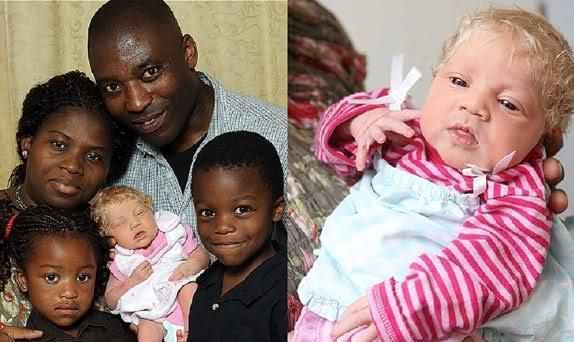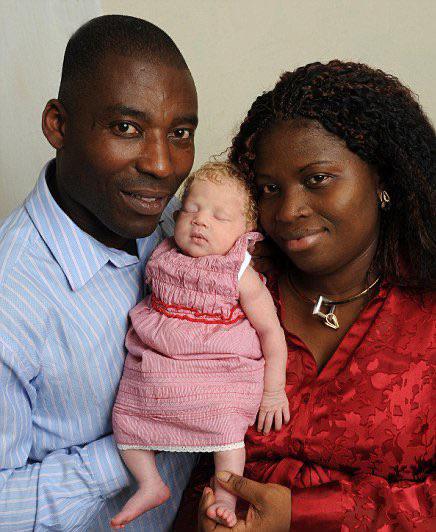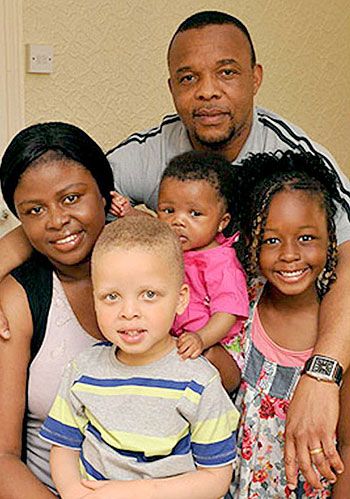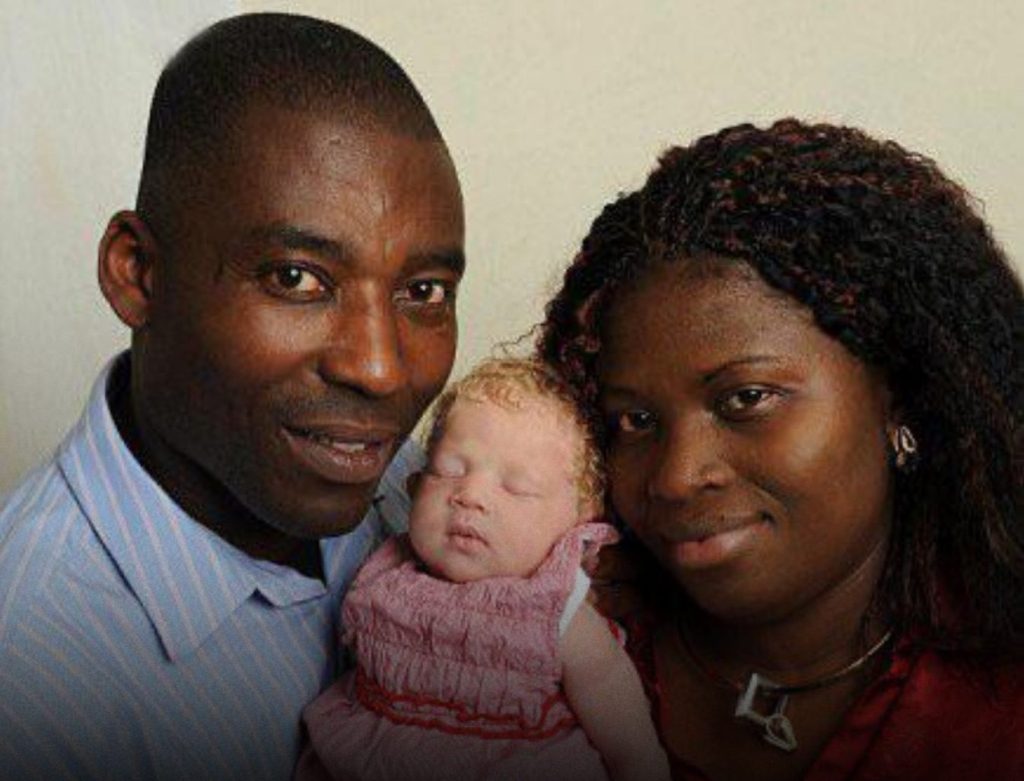In 2010, a Black Nigerian Couple in London Gave Birth to a White, Blonde-Haired, Blue-Eyed Baby — And No One Could Believe Their Eyes
When Ben and Angela Ihegboro walked into Queen Mary’s Hospital in Sidcup, London, in July 2010, they were just like any other expectant parents. They were filled with anticipation, nerves, and the quiet excitement that comes with knowing their family was about to grow. Both were of Nigerian descent, with deep brown skin, dark eyes, and black hair. They already had two children, both of whom resembled them in the way most children do — carrying features passed down from generations before. But nothing could have prepared them for the moment they first laid eyes on their third child, a little girl they would name Nmachi.

When Nmachi entered the world, there was a moment of stunned silence. Nurses exchanged glances, a doctor paused mid-sentence, and even Ben and Angela were briefly speechless. The newborn had creamy white skin, a head full of golden blonde hair, and striking blue eyes. She didn’t look like her parents, her siblings, or anyone else in their extended family. Angela later recalled looking at her baby for the first time and thinking, “She’s beautiful — she’s a miracle.” The press would soon echo that sentiment, dubbing her “the miracle baby.”
Word of Nmachi’s birth spread quickly. Soon, the family found themselves at the center of a global media storm. Headlines asked questions that seemed almost impossible: How could two Black Nigerian parents have a white baby with blonde hair and blue eyes? Some speculated wildly, others doubted, and many were simply fascinated. But behind all the attention was a family simply trying to enjoy the arrival of their newest member while also processing the surprise themselves.

Doctors reassured Ben and Angela that there was nothing medically wrong with Nmachi — she was perfectly healthy. But they also admitted that her appearance was highly unusual. Genetics can be a mysterious thing, and sometimes, traits that seem to come out of nowhere are actually echoes from deep within a family’s ancestry. Scientists suggested three possible explanations for Nmachi’s unique features. One theory was that she might have a rare genetic mutation affecting pigmentation, something that can happen spontaneously and cause a child to be born with much lighter skin and hair than their parents. Another possibility was that she could be the result of a dormant white gene passed down through generations, finally expressing itself in her. This wouldn’t be unprecedented — history is full of examples where unexpected traits skip multiple generations before reappearing. The third possibility, though less likely, was that Nmachi might have a form of albinism. However, her hair’s golden tone and her skin’s healthy pigmentation made that theory less convincing to the doctors who examined her.
Ben, a customer service adviser at the time, laughed off the speculation that arose from strangers. “Of course she’s mine,” he told reporters. “My wife is true to me. Even if she wasn’t, the baby wouldn’t have looked like that.” His statement was more than a defense; it was a declaration of love and trust in his family. Angela, a full-time mother, shared his sentiment. For her, Nmachi’s birth was simply part of life’s unpredictability. “She’s a miracle,” she repeated. “We love her the way she is.”

The Ihegboros’ story touched people around the world because it spoke to the beauty and complexity of human genetics, but it also challenged simplistic ideas about race and heritage. In a world where appearances often lead to assumptions, Nmachi’s arrival was a reminder that biology doesn’t always follow the patterns we expect.
In the weeks after her birth, geneticists and biologists weighed in, explaining that skin color is determined by multiple genes, and the combinations passed from parents to children can produce surprising results. While it’s more common for children of mixed-race couples to have varied appearances, it’s still possible — though incredibly rare — for two parents of the same race to have a child whose features differ dramatically from theirs. In Nmachi’s case, whatever combination of genetic factors came together resulted in a little girl who seemed to defy probability.
Over time, the media frenzy died down, and life for the Ihegboro family returned to a quieter rhythm. They focused on raising their children away from the constant public gaze, choosing to protect Nmachi from being defined solely by her appearance. Still, her story would periodically resurface in newspapers, magazines, and online articles, often accompanied by the same photo of her nestled in her parents’ arms, her golden curls shining against their darker skin.

While much of the world focused on the “how,” the family themselves were more concerned with the “who.” Nmachi was not just the baby who shocked doctors — she was their daughter, a sister, a child with her own personality and future. They watched her grow, hit her milestones, and develop her own sense of self, just like any other child.
In many ways, the fascination with Nmachi reveals more about society than about genetics. We live in a world where people are often grouped and labeled by appearance, where physical traits are linked to identity in ways that can be both meaningful and limiting. Nmachi’s birth disrupted those expectations in the gentlest way possible — by being a story about love, family, and the sheer unpredictability of life.
The story also became a gentle reminder for many parents-to-be: children can arrive with surprises. They may not always look the way we imagine or fit neatly into the picture we had in our minds, but those differences often make them even more extraordinary. Ben and Angela’s reaction to their daughter’s appearance — a mix of surprise, joy, and unconditional love — is a testament to what parenthood truly means. It’s about embracing the child you have, in all their uniqueness, without hesitation.
Today, more than a decade later, Nmachi’s story still circulates on social media and in online forums. For some, it’s an intriguing genetic puzzle. For others, it’s a heartwarming reminder that miracles come in many forms. And for the Ihegboros, it’s a deeply personal chapter in their family history — one that began with shock but settled into love, laughter, and the everyday moments that make a family’s life rich and meaningful.
In the end, Nmachi’s birth wasn’t just about genetics or science; it was about the way life can surprise us in ways we never see coming. She entered the world wrapped in curiosity and wonder, but at home, she was simply a daughter, a baby sister, and a cherished part of the Ihegboro family. And maybe that’s the real miracle — not just that she looked so different, but that her arrival reminded us all of the beauty in life’s unexpected turns.


